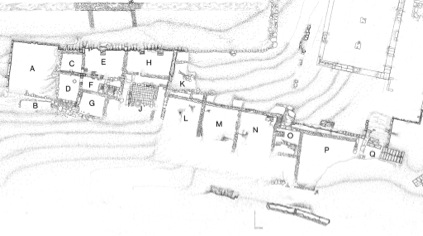(7) Dining Facility
Roman renovation of the 4th century B.C. plan
Vuggy crystalline limestone, trachyte, basalt fieldstones
ca. 22 m x 7.75 m, for rooms c. 6.50 m square
The base of the Western Hill below the Stoa was lined with dining chambers. One set of rooms (L, M, and N) formed a large dining complex divided into three chambers, each measuring approximately 6.50 m on each side. The square plan of the rooms, along with a raised marble border preserved on the floor of the two outer rooms, provides evidence that dining couches once lined the walls of these chambers. Within the marble border, the rooms were paved with marble chips in set cement, while the central room was entirely paved with black and white pebbles set in cement. Here pilgrims could recline and dine as part of the ceremonies accompanying initiation.
The dining rooms faced the nearby Hall of Choral Dancers on the opposite side of the central torrent. Given the very limited passage around western side of the Hall of Choral Dancers to the southern part of the Sanctuary, it is likely that the torrent was covered, at least in large stretches through the center of the Sanctuary. If so, the dining rooms would have communicated directly with the center of the Sanctuary. Although no longer preserved, either a porch or paved terrace on the eastern side of the building provided access to this complex of dining rooms.

In the late Hellenistic period a small square room (O) was attached to the northern end of the central dining complex. Its off-center threshold indicates its function. The surviving floor was composed of roughly cut tessarae set in cement.
Yet another larger square room (P), measuring approximately 9.60 m on each side, was added to the north side of the small chamber during the Roman expansion of the Sanctuary, using mortar to bind fieldstone masonry. It may replace an earlier chamber. Based on its shape and location, it most likely served as an additional dining room.
Selected Bibliography:
- Lehmann, K. 1998. Samothrace: A Guide to the Excavations and the Museum. 6th ed., rev. J.R.
McCredie. Thessaloniki, pp. 114-116. - McCredie, J.R. 1979. “Samothrace: Supplementary Investigations, 1968-1977,” Hesperia 48,
pp. 18-22.
